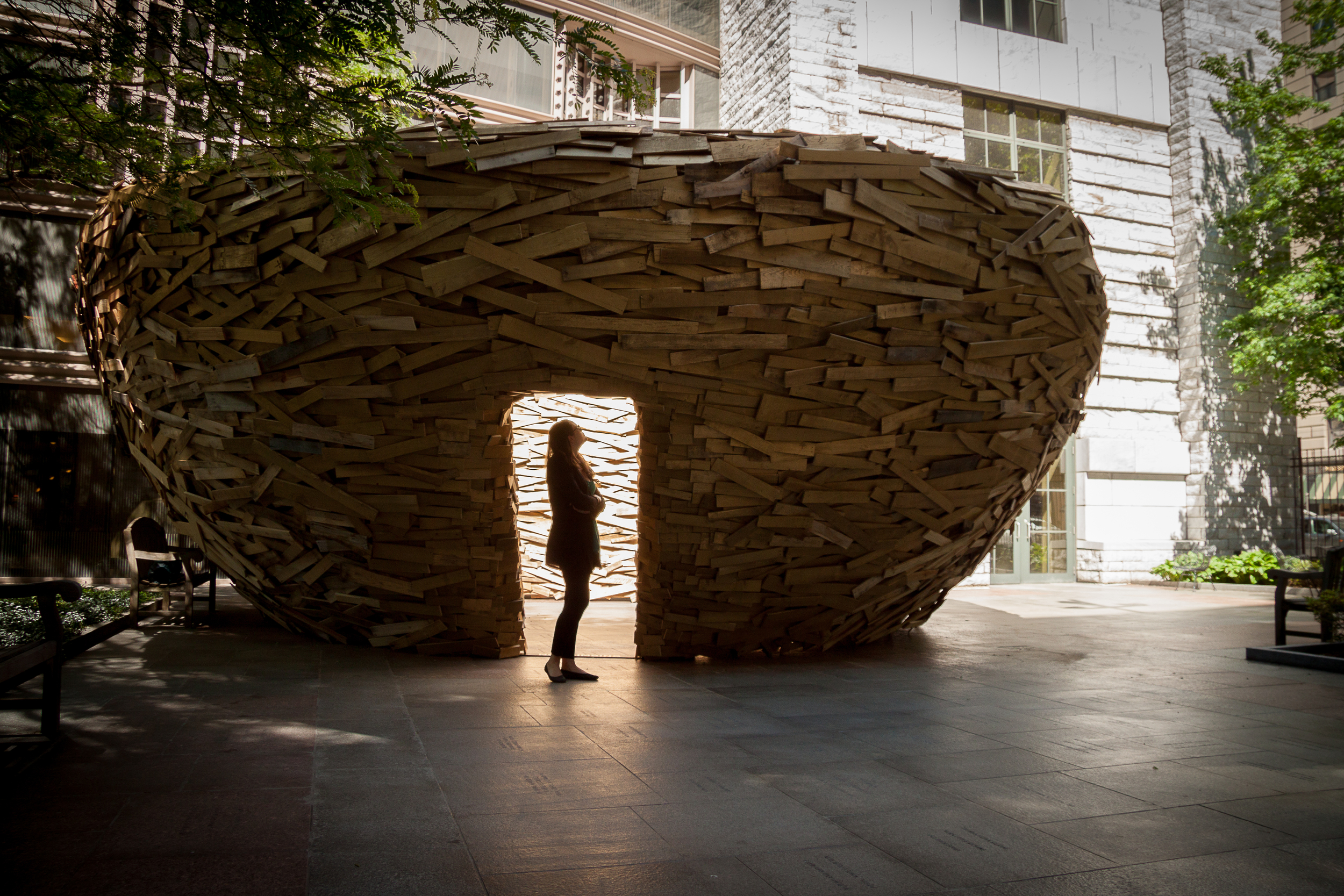It’s challenging to make a convincing argument that incorporating the arts into a library setting could have negative impacts. By providing a platform for local artists and encouraging participation, libraries have become vibrant hubs of culture and creativity, further solidifying their role as essential in their communities.
The purpose of including the arts in a library setting is worth exploring, particularly the type of art commonly featured in these spaces. One predominant form is installation art, which can exist both in private and public spaces. However, I will focus on art installations that exist in public areas and can be “activated” by entering the space they occupy or, in some cases, physically engaging with them.

Installation Shot of the Reading Nest by Mark Reigelman.
Take, for example, the 2013 Reading Nest art installation as part of the See Also program by the Cleveland Public Library. This temporary installation was created by Mark Reigelman, who sought to encourage community engagement and reading. The structure invites the public to enter and immerse themselves in a comfortable, open-air environment surrounded by a wood nest-like structure. A quirky but meaningful art installation that creates a safe place to explore and feel connected to something literally bigger than you. This enhances the aesthetic appeal of the library, fosters a sense of community (social connections with others experiencing the artwork with you), promotes awareness of the library and its resources (a big nest thing in front of a library? Who wouldn’t be interested in it?), and ultimately encourages a love for the arts as well an appreciation of their local library among visitors.
Check out this Video of Mark Reigelman’s process in creating this installation.
In the context of installation art and libraries, something magical occurs when these installations are introduced into spaces where access to information is already abundant. Traditionally, art housed in museums is often kept at a distance from the public—literally placed at arm’s length behind barriers, security guards, and protective glass. While this is understandable, museums have a sterile quality that can be hard to overlook due to this physical separation from the artwork.
Check out this Hyperallergic article: Why Libraries Have a Public Spirit That Most Museums Lack by Laura Raicovich. Raicovich argues that libraries are designed to be welcoming spaces, encouraging interaction and engagement. They provide a tactile experience, especially through their book collections, inviting visitors to touch and explore materials firsthand. This accessibility fosters a connection with knowledge that is often lacking in a museum setting.
Engaging with installation art allows libraries to further enhance this sense of community and creativity. By integrating various artistic expressions, libraries can create inviting environments that promote learning and curiosity, effectively bridging the gap between users and library resources. In other words, libraries that embrace creative outlets to enrich the experiences of their users stay relevant.
Also, museums are not as easy to visit compared to libraries. For instance, while growing up in the San Fernando Valley of Los Angeles County, I needed to have some financial means to commute to a museum and back. I didn’t visit my first museum until I was 16 (via a school field trip), which isn’t ideal because I believe children should be exposed to as much art as possible and as early as possible. Public libraries, on the other hand, can serve as mini art hubs for communities that lack the resources to visit museums. They offer a welcoming space where individuals can explore art, literature, and educational programs without the financial burden. For those who may not have the means to travel to a museum, libraries provide invaluable opportunities to engage with art and culture.
Writing this reflection has made me realize that accessibility is truly foundational for one’s interaction with the world. Libraries bridge the gaps between the impossible and the possible. Moreover, access to art is indispensable; it enriches our lives, fuels creativity, and offers various perspectives that shape our understanding of the broader world.

@msandoval you make such a good point about young people being exposed to art early on. I can’t remember the first time I visited a true art museum. I guess one of the most important was driving from where I lived in northern Indiana to the museums in Chicago as a big day trip and that was probably good but wow to be exposed to like the national Gallery or some such would be so important. I am HO.